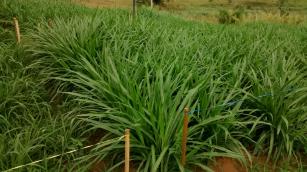Strategies for nitrogen fertilizer application in tropical forage grasses
Strategies for nitrogen fertilizer application in tropical forage grasses

Photo: Gomide, Carlos Augusto de Miranda
Among the essential nutrients, nitrogen (N) is the one with the greatest potential for enhancing forage production. The efficiency of nitrogen uptake is related to the energy supply provided by the photosynthesis. However, recent practices of intensive pasture management have recommended the use of lower post-grazing residues, thus reducing the leaf area of the canopy. The objective of this project was to evaluate the effect of the timing of nitrogen fertilization in association with different defoliation intensities on forage yield and N use efficiency in three tropical grasses. Two experiments were carried out, one in pot with the new cultivar of Panicum maximum, BRS Zuri, and another in plots with mombaça grass ( Panicum maximum), Xaraés grass ( Brachiaria brizantha) and BRS Kurumi (dwarf cultivar of Pennisetum purpureum). The application times of the fertilization were: soon after defoliation or after a week of regrowth. For the pot experiment the defoliation intensities evaluated were 15 and 30 cm associated with N doses of 0, 20, 40, 60 and 80 mg/dm3. In the plots the defoliation intensities were 20 and 40 cm for mombaça grass and BRS Kurumi and 15 and 25 cm for Xaraés grass, and the applied N dose was 50 kg of N/ha. In the pot trial, it was observed that, despite the reduction in root mass in the first week after cutting, there was no effect of the moment of N application on BRS Zuri forage production. The greater mass of forage harvested occured under a lower residue height (15 cm). The increase of N dose increased the number of tillers per plant, the SPAD chlorophyll content, and the harvested forage mass. In the plot study, after two years of evaluations, it was observed that the average interval between cuts was not influenced by the fertilizer application time, being 27 days for Xaraés grass and 24 days for mombaça grass and BRS Kurumi. In terms of production capacity, forage accumulation rate was not influenced by the moment of fertilizer application, but was higher under lower residues. N use efficiency was also not influenced by the moment of application and presented higher values under the smallest residue. The crude protein (CP) content was also not influenced by the moment of fertilizer application in any of the studied grasses. For mombaça grass and BRS Kurumi, a higher CP content was observed under the highest residue (40 cm). This fact is explained by the smaller participation of stems in the forage harvested at 40 cm in relation to 20 cm. BRS Kurumi presented higher protein and lower fiber content in relation to mombaça and Xaraés grasses. These results show that there is a window of time, up to one week after the herd has left the paddock, for performing top dressing fertilization without harming fodder production. Thus, it is possible for the farmer to group two or three paddocks to perform the fertilization, optimizing the workforce.
Ecosystem: Atlantic Forest, Cerrados Region
Status: Completed Start date: Fri Aug 01 00:00:00 GMT-03:00 2014 Conclusion date: Sun Jul 31 00:00:00 GMT-03:00 2016
Head Unit: Embrapa Dairy Cattle
Project leader: Carlos Augusto de Miranda Gomide
Contact: carlos.gomide@embrapa.br
